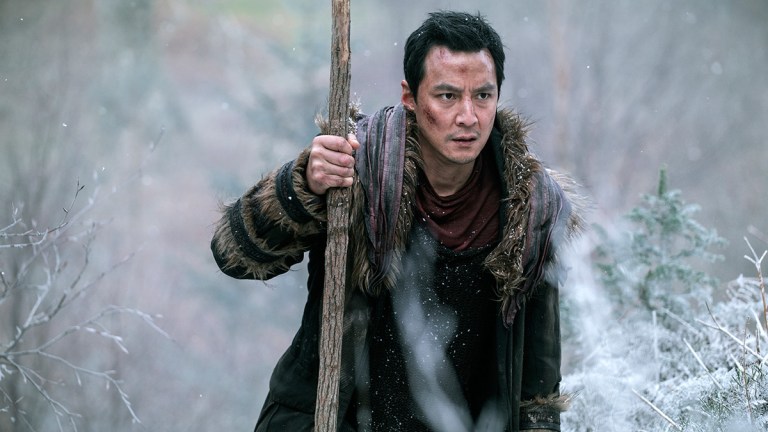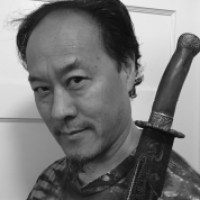Into the Badlands: Daniel Wu On How The Series Became A Cult Hit
Daniel Wu reflects on his groundbreaking AMC series Into the Badlands and what the future might hold.

Since AMC cancelled its martial arts-infused series Into the Badlands in early 2019, it has attracted a cult following with all three seasons available on Netflix. Is it too late to revive the show? Daniel Wu, leading man and producer on the series, is doubtful. “I would never say never but I think the ship has sailed on that one.”
Wu played Sunny, the most lethal “clipper” in the Badlands. Into the Badlands was an original series set in a gun-free post-apocalyptic world where martial arts ruled supreme. Premiering in 2015, AMC cancelled it in the middle of the third season break. Into the Badlands was an extravagant big budget show, with lush costumes, a large cast, and massive sets. And to accommodate the copious fight scenes, it had a separate crew.
“It was expensive to make our show,” Wu admits. “We had two crews shooting at the same time—action and drama at the same time—so you have each crew of 150 people. So it’s like making two TV shows at once. And the budget was high. We were like in the $6-7 million dollar range. Season 3 was almost $100 million to make that. So it’s a big commitment for a studio, right? And I think that’s what probably scared other studios away because they didn’t necessarily see the return on that value. But to do it well you have to really commit to it.”
In the wake of Badlands, several other networks launched martial arts-based series like Warrior, Wu Assassins, and Cobra Kai, but none have taken that extra step of having a fight crew that was equal in magnitude to their dramatic crew. Consequently, the quality of the fight choreography declines towards the end of the season when it should be intensifying. Giving the action crew equal status was unprecedented and has yet to be repeated. But as Wu says, “Shooting a week of drama and then allocating one day for action doesn’t really work for an action show.”
Showrunners underestimate the challenge of delivering quality fight choreography in every episode. A martial arts movie might contain as many fights as two or three episodes of a TV show, and then there’s several more episodes in a season, so television fight crews need to sustain their intensity for much longer. Wu says you can shoot all day for 10 seconds of footage.
“People wanted to jump into it and then realized that it’s not easy to do. The reason why I think Badlands was successful was because we were able to do high level action with high level production value with high level storytelling. And we didn’t want to compromise that.”
Fortunately, the creators of Into the Badlands, Alfred Gough and Miles Millar, had some prior experience with martial arts TV series which helped establish that second action crew. Back in the late ‘90s, they were involved with another unprecedented martial arts-based TV show, Martial Law. That show starred Sammo Hung, the veteran Hong Kong action star (and martial brother of Jackie Chan). Martial Law had multiple martial arts choreographers for different episodes including Stanley Tong, a noted Hong Kong action director, Yuen Tak, another martial brother of Jackie and Sammo, and Andy Cheng, who also served as one of the action directors for Into the Badlands. Gough and Millar knew what they were getting into when it came to fight choreography so having a separate fight action crew was in the mix from the beginning.
Another element that was there from the start was diversity. “All the other characters are very diverse, either strong females, or strong people of color, even the background actors,” Wu says. “This is a directive from the top down that we wanted a very diverse production, so not only people behind the scenes were diverse but from the extra level.”
The Widow (Emily Beecham), Lydia (Orla Brady) and Tilda (Ally Ioannides) were incredibly strong women warriors without pretense. What’s more, they all remained elegantly attired throughout the series, never stooping into gratuitous wardrobe choices. Sunny’s romance with Veil (Madeleine Mantock) was unprecedented in television. Asian male leads are seldom portrayed in relationships with non-Asians. An Asian male coupled with a Black female on TV was extraordinary. This presented a unique challenge when shooting season two and three because the production had relocated to Ireland. “Ireland doesn’t have a lot of people of color,” Wu says, “so we had to really search far and wide to get those extras.”
No matter what gender or race, everyone bleeds the same color. From the opening credits, no one escaped the Badlands without getting bloody. The Badlands were soaked in blood. Wu jokes that blood was one of the most expensive commodities. “One of our props rooms there was just like gallons and gallons of blood everywhere. All different types of blood too. You have thick viscous blood for certain things. Cheap blood for background blood. All kinds of stuff. And then blood for your face, blood for your mouth, blood that goes in your eyes, all kinds of blood. We definitely went through the whole gamut of blood choices.”
Looking back on it now, Wu remembers the Badlands with great fondness. “It was one of my favorite most solid productions I’ve ever worked on.” He felt the show had everything, a great cast, a great story, a big budget and a top-notch production team. The only shortcoming might have been promotions. “I would’ve put more marketing dollars behind it. I wish more people had known about the show because it’s an interesting show because you either heard about it, and love it, or you never heard about it at all.”
Wu is also disappointed that the Badlands cast didn’t get to interact with its fanbase very much. “I wish we had gotten more Comic Cons because the show was built for Comic Cons. We went to one before the show even aired so that didn’t make much sense because nobody knew what it was. And then we went to one right as the show was ending, as it was cancelled. So I wish we had a better presence at Comic Con and had more merchandise and all that stuff. We designed this show for all of that and I think a lot of the potential for that didn’t get realized because we didn’t have much marketing behind it.”
Whether or not Into the Badlands has been permanently clipped, Wu is moving on. Before the pandemic shut down productions worldwide, Wu completed work on two films: Caught in Time, a film based on a true crime spree in the ‘90s, and Reminiscence, a sci-fi film noir co-starring Hugh Jackman, Rebecca Ferguson and Thandie Newton. Caught in Time is completed but its release has been delayed due to the pandemic. Reminiscence is in post-production for release in early 2021.
Is there any chance that Into the Badlands find a new life on the streaming giant Netflix? “We’ll see,” says Wu guardedly. “I mean maybe during the coronavirus time we picked up a bunch of new fans who were able to see the show on Netflix, so maybe if there was enough critical mass to push it forward. Never say never but I think all of us who were involved with it have closed the book on it for now.”
Into the Badlands is currently available to stream on Netflix.
